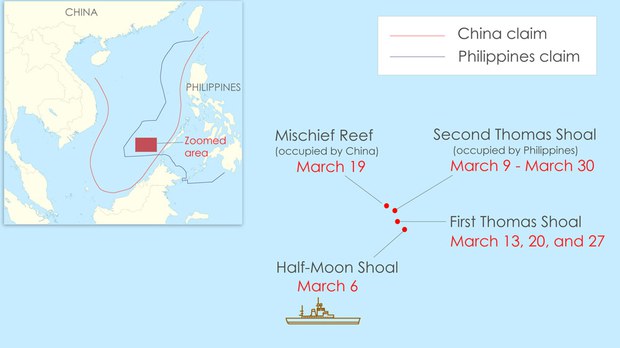Virendra Pandit
New Delhi: After Taiwan, it is the Philippines’ turn in the Far East to take exception to the Chinese expansionist moves.
The developments mark another Chinese attempt to assert its claims over the territories of the South China Sea (SCS).
On Sunday, Manila accused Beijing of water-cannoning its vessels in the SCS to block military supplies and summoned the Chinese Ambassador to register its strong protest, the media reported on Monday.
The Philippines condemned the “excessive and offensive actions” of China against its vessels while Beijing maintained that it took the necessary action to deter Philippine ships which were trespassing and carrying illegal building materials.
The incident took place close to the Second Thomas Shoal, which Manila calls its own, Ayungin Shoal, a submerged reef where a few Filipino troops are stationed on an old US ship from the Second World War, which the Philippines deliberately grounded in 1999 to claim the place and check China’s advance.
“We call on the China Coast Guard and the Central Military Commission to act with prudence and be responsible in their actions to prevent miscalculations and accidents that will endanger people’s lives,” the Philippines armed forces said.
China also shot back. “We urge the Philippine side to immediately stop its infringing activities in these waters,” China Coast Guard spokesman Gan Yu said and asserted his country’s claim over the disputed Spratly Islands.
The Filipinos are angry with Beijing’s calculated moves in the SCS. Many fear a miscalculation or even an accident could ignite an armed conflict.
It all began with a crumbling Second World War-era Philippine navy vessel stranded on a submerged reef in the SCS. It has long been a flashpoint between Manila and Beijing in their territorial dispute over the waters.
Simmering tensions flared again on Saturday last week when the China Coast Guard allegedly blocked and fired water cannon at Philippine vessels trying to deliver food, fuel, and water to Filipino troops stationed on the BRP Sierra Madre at Second Thomas Shoal.
The 100-meter-long BRP Sierra Madre vessel, named after a mountain range in the Philippines, began as the US tank-landing ship USS LST-821, which served in the Second World War. It was later rechristened the USS Harnett County and deployed during the Vietnam War in the 1960s, where it was used as a helicopter gunship base, according to the United States Naval Institute.
After the war, the Philippines Navy acquired it and renamed the BRP Sierra Madre.
When China surreptitiously occupied a nearby and then-uninhabited Mischief Reef, also claimed by Manila, the Philippines took an unusual step to check the advance of Beijing in the hotly contested SCS waters. Manila’s navy deliberately grounded the BRP Sierra Madre on Second Thomas Shoal to get even with Beijing, and to establish a Philippine presence on the shoal.
China has turned Mischief Reef and other reefs and outcrops into artificial, militarised islands to assert its claims in the waters.
Second Thomas Shoal, located in the Spratly Islands, is about 200 kilometers west of the western Philippines island of Palawan and over 1,000 kilometers from China’s nearest major landmass of Hainan Island.
Beijing claims almost the entire SCS, which includes Second Thomas Shoal, and deploys hundreds of vessels there to patrol the waters and swarm reefs.
China also ignored a 2016 international court ruling that its assertion has no legal basis.
Manila says China’s Coast Guard and Navy vessels routinely block or shadow Philippine ships patrolling the waters, and also regularly attempt to disrupt re-supply operations to the tiny Philippine garrison on Second Thomas Shoal.
The Philippine Coast Guard fears China will seek to occupy Second Thomas Shoal if the military detachment leaves.
The Philippines is poorly armed, but the United States assured to defend its longtime ally in the SCS under a decades-old mutual defense pact.
The US has no territorial claim over the waters but has persisted in conducting its own patrols there, which has annoyed Beijing, the reports said.
Washington says this is to ensure what it terms “freedom of navigation” in the sea, through which trillions of dollars in trade passes annually.

